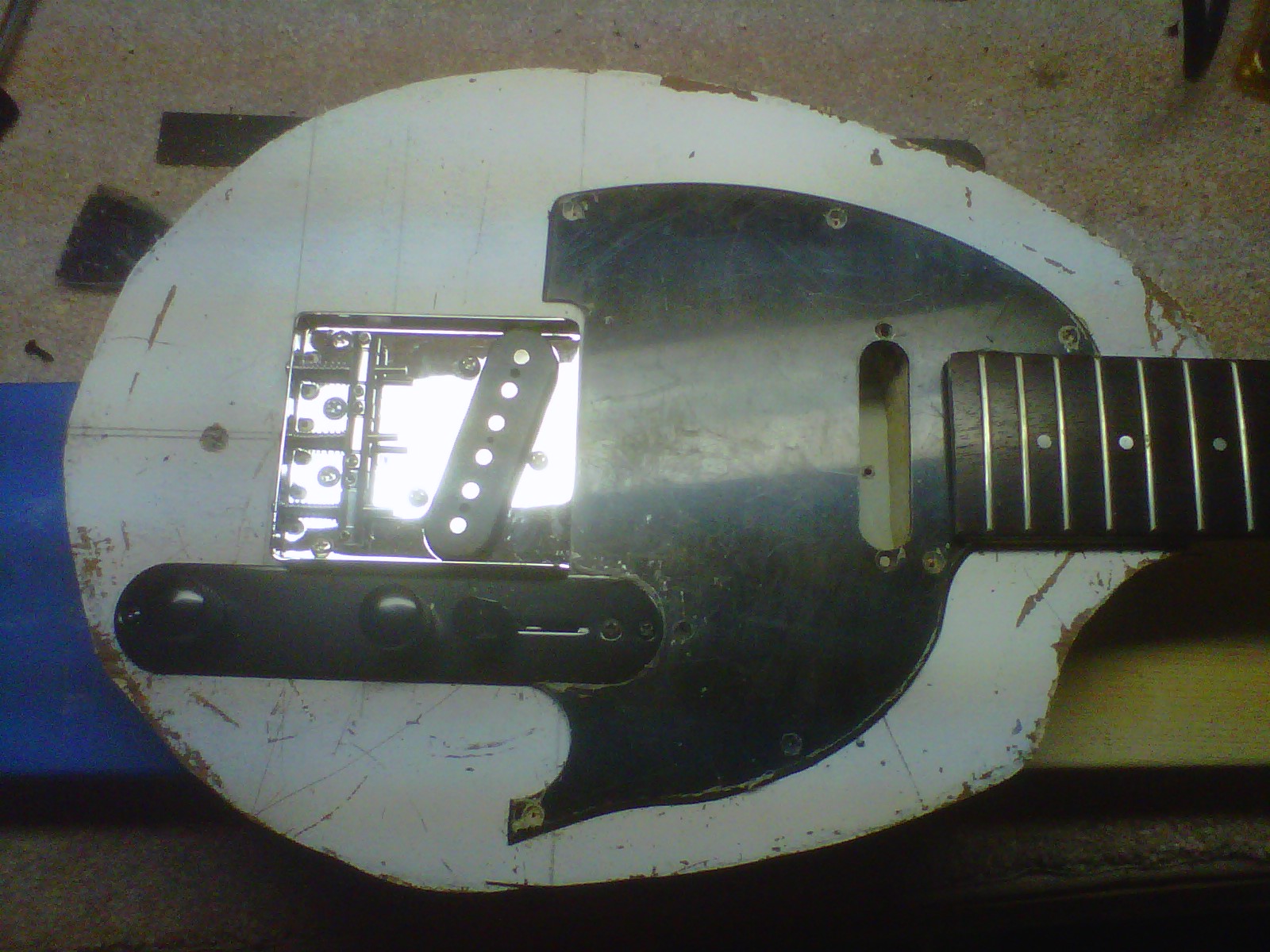I been standing here waiting mister postman
So patiently
So patiently
An early heatwave this past week made work in the shed difficult. Fortunately, the heat coincided with a wait for the arrival of a few parts I had ordered. On Wednesday, the same day I picked up a three-pack of Dunlop strings on my way home, I found the postman had left packages with a half dozen front pickup adjusting screws and a neck bolt kit in my mailbox.
With a coping saw, my Wen and a drill, I customized the Tele pickguard to fit LeSpork's smaller body. After relocating the cutout for the switch plate, I trimmed off the cutaway return and added some countersunk screw holes.
The front pickup attached to the pickguard easily enough with a new pair of screws and latex retainers.
After removing the bridge assembly, I threaded the front pickup wire through, slipped the pickguard in place and attached the pickguard to the body with matching black screws.
Before soldering, I printed out and reviewed the wiring diagram I had picked out and and the switch wiring conversion chart. Going with Tele-esque parts on this prototype, it seemed appropriate to use a Telecaster wiring diagram. After reading up on the various ways Fender has wired them over the years, I decided to go with the current-day wiring method, so I could get a real tone control with each of the three pickup selections: neck, bridge and combined. With this conversion chart, I translated the parallel pole locations from the genuine Fender switch type shown in the wiring diagram to the poles on the enclosed box inline switch that came with my prewired switchplate. Many thanks to my friend and fellow guitar builder Max for help on making sense of these switch diagrams.
After figuring out which wires belonged on which switch poles, I removed the switch plate from the body and started in on the soldering.
The biggest challenge in converting the wiring was relocating the capacitor from the tone pot to its new location between the tone and volume pots. With that done, I added a wire to tie together the outer four switch terminals, grounded the bridge assembly to the volume pot, and attached the two pickup leads to the switch and back of the volume pot.
Before soldering the last two leads to the output jack, I bored out a hole to receive an output jack. With the last bit of soldering done, I screwed in the jack plate and set the body aside.
After removing and reattaching the neck a few times during construction, I had already noticed a difference in how well the screws were gripping the neck. My attempt to install inserts in the neck with a screwdriver so far were not successful, resulting in broken inserts that had to be turned out with pliers. To overcome this problem, I bought a repair kit from an eBay seller. As expected, most of the parts were very close to what I had bought at Lowes. There was one major difference: the kit included a small bolt with an Allen wrench for twisting the inserts into the neck holes.
In addition to the tool that came with a kit, I used a similar but larger machine bolt to tap threads into the holes in the neck that receive the inserts. This extra step made it easier to twist in the inserts with the tools that were in the kit.
After final assembly, I put on a new set of strings. This time, I used a 9-42 guage set, so I made the necessary adjustments to the bridge action and intonation. This change to a lower string guage also resulted in a very flat neck with only the slightest amount of relief and no torque on the truss rod. As this setup did not result in any string buzz, I left it alone.
As soon as I said I was done, my son and I were taking turns, putting this prototype through her paces. Pictured above is my son, playing some power chords with LeSpork. At 8-1/2 lbs., mostly in her chipboard body, she's a heavy and very unbalanced little axe. We both agreed, she needs a cutout on the treble side of her body to be a better player. A set of buttons and a strap would help as well, and I'm reconsidering using a Strat-type output jack to make it easier when plugging and unplugging the patch cord.
At first glance, my daughter's reaction was that it did not look at all like a spork. Through prototyping, I had intended to use graphics to make the tongs of the spork. Using the same color for the pickguard, bridge, body and headstock paint, switchplate assembly and pickups will remedy that some. Using a contrasting color for the negative space of the tongs will also help, as I've mocked-up in the edited picture below.
Is it just me, or does the black pickguard and switch plate against the white body make LeSpork look a little like Texas?



























